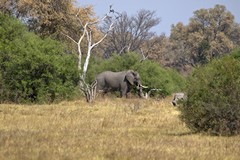
The vegetation in Moremi is very varied,from
grassland and savanna to thick bush and
forest. There are a lot of very large elephants
here
Moremi is a Game reserve located within the Okavango Delta. You can see it's position on the delta (map).
It was named after chief Moremi of the BaTawana tribe. It was designated as a Game Reserve so that the BaSarwa bushmen who lived there were allowed to stay in the reserve. The chief's widow made the first moves to conserve the game in the area due to concern about over hunting in the area. A far sighted woman indeed.
Only about 30% of the reserve is mainland, most of it is within the Okavango delta itself. Chief's island is the most well known area. Most of my discussion here refers to the drier parts that are usually accesible by car.
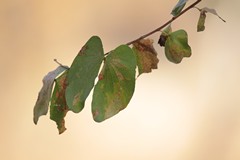
These are Mopane leaves. They have a give
away 'butterflies wings' appearance
It contains areas of mopane woodland - especially in the Mopane tongue to the south east, which outside the delta area, and also acacia forests, floodplains, scrub and lots of small lakes and lagoons. Some areas are savannah grasslands.
Mopane is extremely important to the park as its leaves are highly nutritious and help to support the large elephant population.
Partly due to its varying habitats Moremi holds a large variety of game including all of the big five. It is a stronghold for Painted wolves, also known as African hunting dogs.
Not all of the reserve is open to the public and there are many private concessions within it. These concessions are generaly obscenely expensive to stay at, partly due to Botswana's policy of low volume high quality tourism in order to reduce environmental impact, and partly due to the reputation of the Delta as a wildlife viewing area held by Americans boosting the prices.
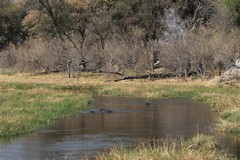
With the extensive waterways and lakes, and
abundant grassland within Moremi, the
hippopotamus does well here
The upside of this is less traffic and so a better wildlife viewing experience. I cannot comment further on the quality of wildlife viewing in the private concessions a we did not visit any of them.
The area around Khwai, Xakanaka and South gate is generally the publically accessible part. The game in the area is good, especially around Khwai, although maybe not as fabulous as it is hyped up to be, especially when compared to places like Ruaha and Selous in Southern Tanzania or Meru in Kenya.

The treeline in the distance delineates the
floodplain, now drying out as the water
recedes
The biggest downside to this area is the number of cars that tend to congregate on sightings of big cats or wild dogs (although not as bad as in Savuti). There are several public campsites and so a feature you will encounter here are self drive safaris, something far less common in East Africa. However I would recommend using a professional guide as they can spot much more game than me and probably you as well.
Getting around is easy in a 4WD although the tracks are often sandy and slow progress down a good bit. There is a lot of water about which means getting from A to B can be a circuitous process with many roads becoming waterlogged, more so in the flood season, but this is a good thing as a game drive shoudn't be rushed.
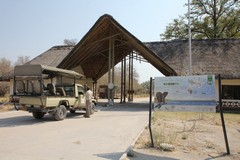
This is the entrance to the reserve at South Gate
Large herds of lechwe are commonplace, as are impala and kudu. Pods of hippo are easy to spot in the lagoons and wider channels. Elephants of course are almost everywhere. We did notice there appeared to be more batchelor groups than breeding herds whilst we were there in August, but great photography was to be had watching the herds splash about in the water.
Parts of the reserve are only accessible by boat, and it is a totally different experience to explore the channels and interconnected lakes within the swamps. There is little other boat traffic at present and it is unlike anywhere else I have been in Africa - totally enthralling as each bend reveals a new and different vista, or conversely the delta closes in on both sides to form a narrow channel almost touching the boat. Huge beds of papyrus sway in the breeze, and many types of heron, kingfishers, bee eaters and other waterbirds pass overhead. Occasionally other wildlife is spotted.
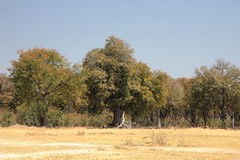
There are stands of mature woodland,
especially in the Mopane tongue area in the
Southeast
In the more remote areas you can catch glimpses of the elusive sitatunga, before they either duck down in the reeds, or run for cover. It is a fantastic green contrast to the other parts of Moremi where the vegetation is dry and the grasses are yellowing in the heat.
When exploring the watery swamp you can use a boat or a traditional type of canoe called a mokoro. Mokoros used to be made of leadwood trees but these are now becoming rare so most are made of fibre glass. Mokoros are very relaxing but you don't travel far. To get a broader view of the wetland I'd go for the mororboat safari.
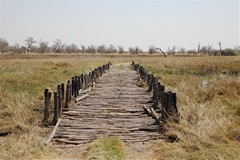
There are several wooden bridges in Moremi.
This one is known as 4th bridge. There are
any number of incredibly boring videos on
U tube of people pretending they are being
adventurers crossing these bridges if you
are interested
The Dry season runs from April to October and is characterized by cooler, dry conditions until September when it quickly heats up again. The Wet season, from November to March, receives the majority of the reserve’s rainfall, along with higher temperatures. Rainfall is in the region of 450mm annually. Overnight temperatures in the coolest months of June and July can dip close to freezing but still average 26 C during the day.
Of course most of the reserve's water comes from the influx from the Kavango river, which works its way down through the delta to Maun over several months and peaks in the cool months of June and July. Maun and other southern areas receive only 2% of the seasonal floodwaters.
Once the floods start to recede the exposed land quickly greens up, and attracts as many as 260000 animals from the surrounding areas, which are very dry.
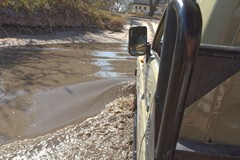
Depending on the time of year the roads are
more or less likely to be flooded in places
October is the hottest month just prior to the rains and easily tops 35C.
There has been an increase of poaching in Botswana recently, despite the excellent job done by the Botswana Defence Force and park rangers. It is nothing like East Africa, but needs to be carefully monitored. Bushmeat poaching is also thriving.
In 2019 there was a large increase in rhino poaching and so they have had to round up the rhinos and move them to a safe sanctuary. This has coincided in changes is the policies of protecting the area implemented by the new government.
Trophy hunting of elephants is now reinstated in selected areas of Botswana (Not Moremi) as of May 2019, as foreign hunters have swayed the government in favour of resuming it as a response to Human Wildlife Conflict. As a conservation measure it is nonsense but money speaks volumes in Africa. It also makes a joke of the statement made by the government that Botswana should not be told how to implement conservation measures by the West.
Trophy hunters will target the best bulls with the biggest ivory, even though much of the crop raiding is done by cows with calves. The damage will be to the gene pool as there will be less bulls with large sized ivory around to pass on the trait to future generations.
Botswana's reputation for conservation will also take a severe blow. Elephants are dwindling all over Africa and this should never have been allowed to happen. It will not solve the HWC problem, and other countries are tackling it without resorting to killing.
Watch the Moremi in August video.